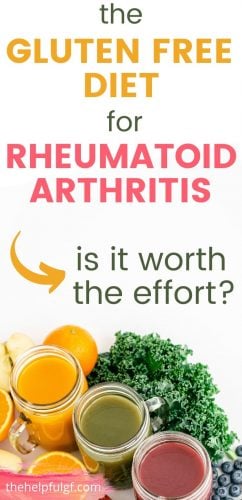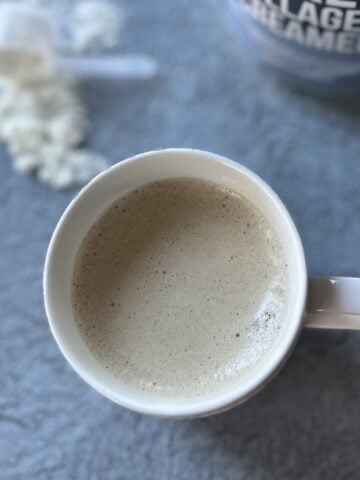If you’ve been diagnosed with rheumatoid arthritis, are there actually benefits to transitioning to a gluten-free diet?
This is a guest post by Maly at the The Rheuma Mill on her personal experience with Rheumatoid Arthritis.
The Gluten-Free Diet and Rheumatoid Arthritis
Keep reading to find out: What is Rheumatoid Arthritis? Who is at risk for Rheumatoid Arthritis? What's the connection between the gluten-free diet and rheumatoid arthritis? What are the best tips for making the switch to gluten-free?
SCROLL DOWN TO LEARN MORE ABOUT MALY AND HOW SWITCHING TO THE GLUTEN-FREE DIET BENEFITED HER RHEUMATOID ARTHRITIS SYMPTOMS!
Are you new here? I also have the following posts to help you live gluten-free without the stress!
- How to live a gluten-free lifestyle when you are CRAZY busy
- The ULTIMATE guide to gluten-free skin care
- How to eat out SAFELY when you’re gluten-free
- How to make ANY recipe gluten-free
- 4 Steps for preventing gluten CROSS CONTAMINATION in the kitchen
…and of course, you should join my EXCLUSIVE Facebook community “Stress-Free Gluten-Free” by clicking here!
The gluten-free guide below is based on personal experience and research. Always be sure to discuss any medical changes with your doctor for your personal medical needs. My full disclosure isn’t that interesting, but you can find it here.
What is Rheumatoid Arthritis?
Rheumatoid arthritis (RA) is the second most common form of arthritis after osteoarthritis. Did you know that there are over 100 types of Arthritis? I didn’t either until I was diagnosed with Rheumatoid Arthritis and started researching about the disease that stopped my life in its tracks.
Ask any warrior (we are warriors not sufferers) of Rheumatoid Arthritis and they will tell you that they would not wish RA upon their worst nightmare. The symptoms are debilitating. Why? Rheumatoid arthritis is an auto-immune condition that affects the joints in the system.
More specifically, the immune system will attack the lining of the joints (synovium). When the synovium becomes inflamed, the synovium will thicken causing swelling, stiffness and joint pain.
The most common areas of pain are the hands, wrists and ankles but larger joints such as the hips and knees can also be affected.
As the inflammation progresses, those with RA will also experience extreme fatigue.
Who is at risk for Rheumatoid Arthritis?
Rheumatoid arthritis sounds like something that only affects older people but this is not the case. There is such a thing as juvenile arthritis and children as young as 4 can be diagnosed with the disease.
There is no conclusive cause for why rheumatoid arthritis occurs but chances of rheumatoid arthritis developing increases if you are a smoker or have a family history of RA.
In my particular case, I was diagnosed at 38. I was young (still am!), healthy, working full time as a special needs teacher, engaged in Mixed Martial Arts and pole dancing and an active parent of 3 pre-teens.
I have never smoked a cigarette in my life and have no family history of rheumatoid arthritis. It came out of nowhere and hit me like a freight train.
I went from being able to move and do everything you would expect a normal 38 year old could do to a person that could no longer straighten their fingers or kneel and getting on the floor was to be avoided at all costs. The process (it is literally a 6 step process) of getting back up off the floor was laborious and just down right embarrassing.
Not being able to sit on the floor is a big problem when you work with small children.
You can read more about my RA story here.
Is a Gluten-Free Diet Good for Rheumatoid Arthritis?
Medical Treatments for Rheumatoid Arthritis
The medical treatments available for Rheumatoid Arthritis are many and often come with serious side-effects.
If you have just been diagnosed with rheumatoid arthritis, chances are you’ve been prescribed a cocktail of different pills and now have to spend weeks if not months waiting for them to kick in.
There is no cure for rheumatoid arthritis but medication is there to reduce swelling and prevent long term damage but finding the right combination can take years.
One of the main prescribed medications of RA is methotrexate, a common cancer drug. This one comes with many warnings and the one that rheumatoid arthritis warriors find most scary. It’s a cancer drug.
Methotrexate also comes with regular blood tests to make sure that it doesn’t damage your internal organs. If you are a female of child-bearing age, you also have to use a reliable contraceptive because you should not get pregnant while you are taking it.
Other commonly prescribed drugs for RA such as Celebrex and Plaquenil have been known to cause hives, affect vision, trouble breathing, sun sensitivity and complications with skin--just to name a few.
So why would anyone take it? Let’s put it into perspective:
If you were in pain constantly and can’t even pull up your own pants because you can’t even bend your fingers, you’d probably take anything to get your life back.
There were many mornings where I nearly didn’t make it to the bathroom because my knees and ankles were locked and I couldn’t even flick on the light switch because my fingers were so swollen. At that point, I was willing to take anything for relief!
Take this quick quiz and uncover the secrets to making your gluten-free lifestyle not just manageable, but truly enjoyable with custom recipes and tips!

Other Treatments for Rheumatoid Arthritis
Early detection is the key to avoiding harsh drugs.
Those that have found success in controlling their Rheumatoid Arthritis symptoms using holistic methods are usually those that recognized the signs early and sought medical attention before the inflammation really takes hold.
The most common holistic method is diet focused whereby an RA warrior will include anti-inflammatory foods in their diet and/or eliminating foods that are known to trigger symptoms of their rheumatoid arthritis.
Along with this approach, some of the best supplements for arthritis include turmeric, Glucosamine and Chondroitin which may help reduce inflammation and support joint health.
I say ‘their’ rheumatoid arthritis because every warrior is different, what works for one may not work for another.
In saying that, there is one practice that many RA warriors will swear by: eliminating gluten.
The Gluten-free Diet and Rheumatoid Arthritis
There is a general acceptance that eating a gluten-free diet is good for rheumatoid arthritis.
In fact, many rheumatologists will recommend to their patients to trial a gluten-free diet and subsequently, many patients report less joint pain.
The most persuading factor in the connection between a gluten-free diet and rheumatoid arthritis is that Celiac Disease is also an auto-immune condition and can often be co-morbid with Rheumatoid Arthritis.
Aside from the obvious health benefits, one of the other major contributors of a gluten-free diet’s popularity for people with rheumatoid arthritis is the weight loss benefits.
Most of the medications prescribed to people with rheumatoid arthritis can cause considerable weight gain particularly due to the large dosage amounts.
Many people lose weight on an anti-inflammatory gluten-free diet, so this is a legitimate win for solidifying the relationship between the gluten-free diet and Rheumatoid Arthritis.
Gluten-Free Diet Benefits for Rheumatoid Arthritis.
My gluten-free diet journey began 10 years ago when my eldest child, Cree, was diagnosed with Autism.
Not long after his diagnosis I started him on a gluten-free diet. Living gluten-free 10 years ago was hard work and expensive so it was just Cree that made the transition to gluten-free, not the whole family.
I can’t tell you how wonderful it is that the gluten-free movement has grown as much as it has in terms of availability, affordability and variety.
Click here to learn more about eating gluten-free on a budget.
When my rheumatoid arthritis symptoms began to really take hold of my body, it was a no brainer to go gluten-free.
I am a big believer in ‘food is medicine’ and was confident that by tweaking my diet, I was going to see some changes in symptoms.
Once I made the conscious effort to go gluten-free, the benefits were quick--as in the next day.
More specifically:
- I had less swelling,
- more movement,
- and I was a step closer to being able to make a closed fist.
For anyone with rheumatoid arthritis, these are huge wins!
Changing my diet to gluten-free also meant that I could maintain my weight.
Staying in shape and getting movement back was so important to me as I wanted to return to training as soon as possible not just for my physical health, but for my mental health. I needed to feel strong again.
On top of all that, I needed to feel that I was actively trying to do something to help myself.
Over time, I have been able to reduce my medication which started at 16 pill/supplements a day to 6 a day.
My joints are out of the inflammatory phase and into the healing phase. I no longer have any pain and can for the most part, function normally. I am not at 100% function but I am moving in that direction.
This means I have returned to training and feel that I am getting my strength back.
I no longer have to take Methotrexate and Celebrex. Woo hoo!
Those two meds were my main concerns and the two I wanted (needed!) to get off as soon as possible.
I do believe that going gluten-free has helped my body to heal and rely less on pharmaceuticals so I can definitely vouch for the marriage between a gluten-free diet and rheumatoid arthritis as I have seen the results first hand.
You can read more about my treatments here. http://www.therheumamill.com/rheumatoid-arthritis-treatment/
I highly recommend all those with rheumatoid arthritis to make the change to gluten-free to see if it is a cause of your flares.
If you’ve been newly diagnosed, depending on the severity of your symptoms, talk to your doctor about diet changes before trying the pharmaceuticals.
Tips for Transitioning to a Gluten-Free Diet with Rheumatoid Arthritis
If you’ve never done gluten-free before, these are my top tips during your transition:
Tip #1: Focus on what you CAN have not what you can’t have
There is so much variety and substitutes now available that you won’t be missing out on much. Even if you’re going out to eat, there are not many eateries that won’t cater for you.
Tip #2: Plan ahead
You don’t have to go crazy with this but just having things on hand to snack on will prevent you from quickly grabbing something you don’t really want to be eating.
For taste-approved gluten-free snack suggestions, see this post!
Tip #3: Remember why you’re doing it
Don’t turn it into a mental game. Focus on why you’re making this change. Remember your worst day. I remember having to ask my son to help me put on my bra. Don’t want to subject neither one of us to that again!
My rheumatologist said to me during one of our first consultations that there is light at the end of the tunnel but the length of the tunnel is unknown and is different for everyone.
So that is my focus, to keep heading towards the light at the end of the tunnel.
Going gluten-free has made that tunnel a little shorter and put me closer to the light at the end. I hope it will for you too.
What's they key to loving your gluten free life? Get your personalized plan with the guide you need to thrive!


About Maly:
Hello! I’m Maly. I’m 39, a single mother of 3, a full time special needs teacher and motorbike rider. I love to travel and can proudly say that I have ticked off every item on my bucket list! Now I can add rheumatoid arthritis warrior to my list.
Maly is the owner and creator of The Rheuma Mill.

Love this information? Be sure to pin it to Pinterest to find again later or share it with your friends using the social buttons below.
Other posts you may like:
- The best tips for raising gluten-free kids from REAL parents
- My TOP recommended gluten-free products
- The ultimate guide to gluten-free SKIN CARE
- Mega list of gluten-free TOOTHPASTE brands





Richard Hoover
Thank you a lot for sharing your experience!
thehelpfulgf
Thanks for the comment! Hope it was encouraging.